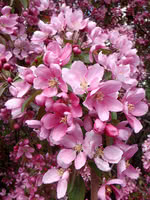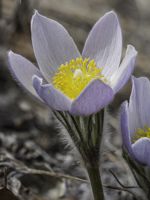Mon-Fri 9am - 5pm Mountain time
Thunderchild Flowering Crab vs Prairie Crocus
Malus x adstringens Thunderchild
Pulsatilla nuttalliana (Anemone patens)
NOT AVAILABLE THIS SEASON - MIGHT RETURN
Thunderchild Flowering Crab is a hybrid crab apple known for its attractive and fragrant dark pink blossoms and deep purple mature leaves.
Tree farmers will find this hybrid appealing as a pollinator for other apples, while home growers will enjoy the red pome's ability to attract flocks of Cedar Waxwings in the early spring.
This species is reportedly resistant to fireblight.
Prairie Crocus is a native perennial wildflower that is often considered one of the first signs of spring. The flowers can range from purple, pale blue, to white and often appear before the snow has fully melted. It can bloom a month earlier than other spring flowers, providing an early source of pollen for a variety of pollinators.
The plant is covered in woolly white hairs, including the finely divided leaves, giving them a silvery appearance. Prairie Crocus leaves do not fully emerge until after it has bloomed. The spent blooms transform into fluffy, feathery seed heads. During the hot summer months, the Prairie Crocus goes dormant and will repeat its life cycle the following spring.
The Prairie Crocus is Manitoba’s provincial flower.
Thunderchild Flowering Crab Quick Facts
Prairie Crocus Quick Facts
Toxicity: all parts toxic if eaten, sap can irritate skin

